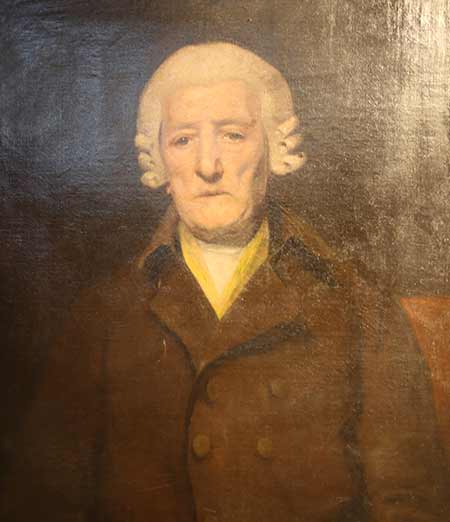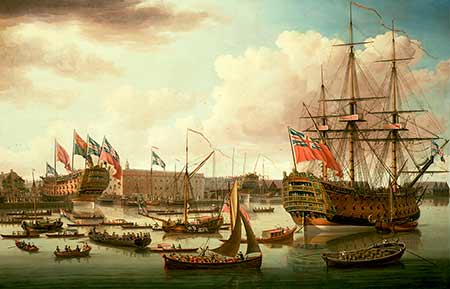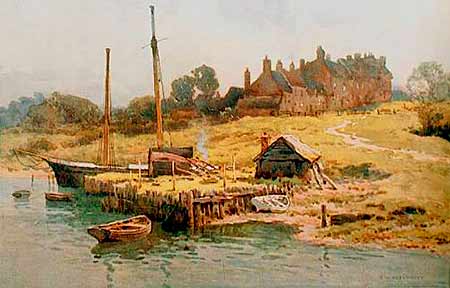Henry Adams and his shipbuilding sons
Henry Adams' name is absolutely synonymous with shipbuilding at Buckler's Hard. He was actively involved in the work for almost 50 years before passing responsibility over to his two sons.
(1) A venture responsible for the construction of many notable Men of War
Born in 1713, Henry Adams in 1744 was sent to Buckler's Hard from his post as a shipwright at the royal shipyard at Deptford, to oversee an Admiralty contract placed for the construction of a 24-gun ship, the Surprise.

Such secondments usually finished on completion of the related contract and the overseer would return from whence he came, but Adams by 1748 had married a local girl and, with support from the Duke of Montagu's steward, had set up as a shipbuilder and succeeded John Darley at Buckler's Hard, where he was to stay until his death in 1805.
Adams quickly obtained a contract to build the 24-gun sloop, the Mermaid, which was launched in 1749, and after a brief absence of additional naval contracts, and despite further business cycle peaks and troughs, went on to build the hulls of many of the famous wooden warships of the day, including notable vessels used by Horatio Nelson's navy during the Napoleonic Wars.
From 1793, though, the day-to-day running of the shipyard was put in the hands of Henry Adams' sons, Balthazar and Edward. But although no longer directing shipyard operations, the old man had a semi-circular room built at his home, now the Master Builder's hotel, bar and restaurant, from where he would watch the shipwrights at work, calling them to him to be corrected whenever he noticed something of which he disapproved.
Buckler's Hard naval contracts after that time were in names of both sons: B & E Adams who completed a number of merchant vessels and a further fourteen Men of War - the last, the 74-gun Hannibal, was completed in 1810.
(2) Launch days
Launch days for some of the larger vessels were well-attended, joyous occasions, often the culmination of up to three years hard work by shipwrights, craftsmen, labourers and others.
Dignitaries often named the vessels and a bottle of wine was sometimes broken on the bow.

But dignitaries could not always be relied upon - following the launch in 1800 of the 74-gun Spencer, for example, the Portsmouth Telegraph reported that 'as Earl Spencer did not come, as was expected, to name her, she was christened The Spencer by Sir Charles Saxton...' and went on to say that 'although the weather was unfavourable, a great company was assembled on the occasion' further noting that 'Mr Adams provided a costly and elegant collation for his friends.'
And then in 1804, at the launch of the 74-gun Swiftsure, between 3,000 and 4,000 people attended, some travelling in on foot and others in carriages. One hundred and ten guests were entertained at a celebration dinner, and the Ship Inn is said to have served an impressive 2,100 pints of beer.
But there was, of course, also serious business to be conducted as the hugely impressive hulls - 74-gun vessels were typically 170 - 180 feet long and almost 50 feet in breadth - were slid into the water. When in mid-stream, men on the deck threw ropes to others in small boats prior to what has been described as 'the long and strenuous tow' by men in rowing boats, to Portsmouth where masts, rigging and fittings were added.
(3) Unfortunate but almost inevitable decline
The firm's fortunes had gradually declined, however, culminating in bankruptcy in 1811 at a time when there were no large naval contracts to be had.
But other factors were also at play.
Since 1763, for example, Henry Adams had business interests in another shipyard, at Deptford, but in late 1793, these interests ceased, and the family became dependent upon the success of Buckler's Hard.

Furthermore, naval contract prices were more aggressively set after 1802, and made no allowance for the roaring inflation then prevalent; raw material costs increased and availability declined as the firm lost its previous almost monopoly access to Beaulieu estate timber; and vessels were frequently delivered late, which resulted in the imposition of substantial Admiralty penalties.
And finally, ill-advised litigation was taken against the Admiralty, with disastrous but fairly predictable consequences.
And so what had for many years been a remarkably successful enterprise came to an end.
The brothers, however, continued separately as shipwrights at Buckler's Hard, Balthazar until 1819 and Edward until 1838, surviving on a declining order book of merchant and small navel vessels, coastguard cutters and odd jobs, fighting a trend as the industrial revolution progressed for shipbuilding more and more to be concentrated in the towns.
The last Men of War completed at Buckler's Hard were the 20-gun Medina and the 20-gun Carron in 1813 by Edward; and the 18-gun Tay (1813) and 24-gun Towey (1814) by Balthazar.
At the grand old age of 92, Henry Adams died and was buried on the 3rd November, 1805 at Beaulieu Church. His second wife, Ann, passed away in 1827 at the age of 89 and was also buried at Beaulieu Church. Balthazar died in 1821, aged 55, whilst Edward died in 1849, aged 82.
Edward's widow and executors leased the shipyard until her death in 1852 whereupon the Adams' active shipbuilding connection with Buckler's Hard ceased. The lease was taken on by others: William Scanes until 1872, and Frederick Buckle from then until 1883, although little shipbuilding took place and by the early 1890s the village was described as a 'deserted shipyard'.
Find out more about Buckler's Hard's fascinating history
References:
Bucklers Hard - a rural shipbuilding centre: A.J. Holland
An Album of Old Beaulieu: Susan Tomkins
Hampshire Place Names: Richard Coates
Historic England - Buckler's Hard
Beaulieu History Society Newsletter - Henry Adams: shipbuilder
Various Wikipedia pages
Quick links
More links
Other related links
Search this site

